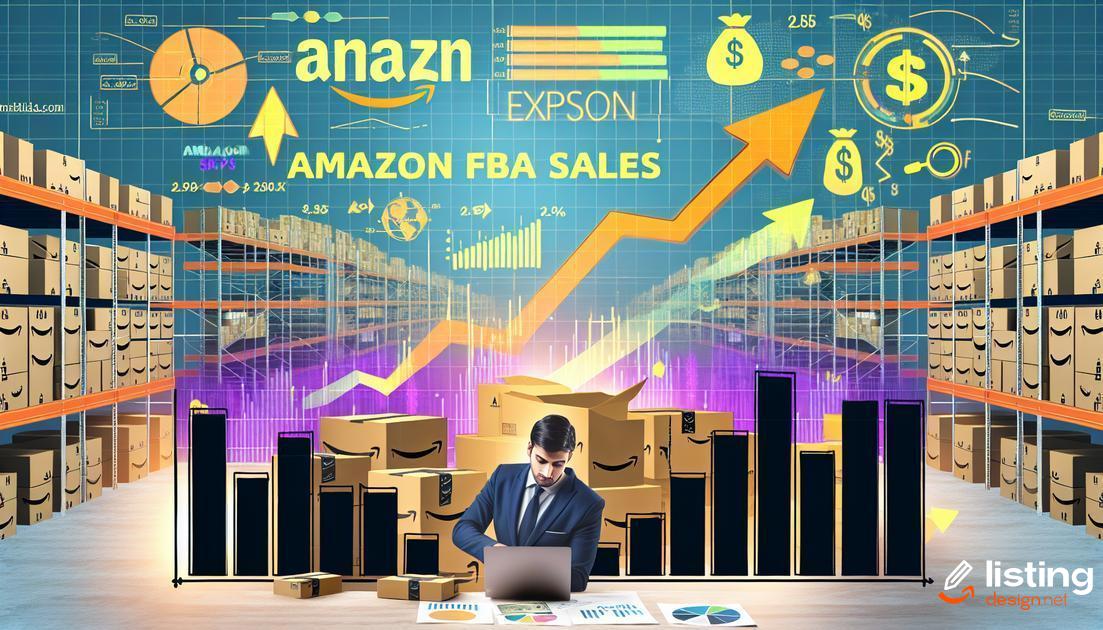Calculating Amazon FBA profits is a crucial step for any seller. Knowing how much you earn helps you make informed business decisions. In this guide, we’ll explore the tools, techniques, and tips to ensure you maximize your earnings. Whether you’re new to FBA or an experienced seller, understanding your profit margins can make a significant difference.
Table of Contents
Understanding Amazon FBA Profit Margins
Understanding Amazon FBA profit margins involves examining the balance between revenue and costs associated with selling products through the platform. Key factors influencing profit margins include:
- Product Costs: The cost of manufacturing or purchasing inventory directly impacts profitability.
- Shipping Fees: Fees for sending inventory to Amazon’s fulfillment centers.
- Amazon Fees: These include referral fees, variable closing fees, and FBA fees.
- Storage Fees: Charges for storing products in Amazon’s warehouses, which vary based on size and duration.
- Returns and Refunds: The cost associated with handling product returns or refunds.
- Promotions and Discounts: Offering discounts might drive sales but reduce profit per item.
By carefully analyzing these components, sellers can determine their net profits and adjust strategies to enhance their profitability.
Essential Tools for Calculating FBA Profits

To excel in Amazon FBA, it’s crucial to use essential tools for calculating FBA profits. These tools can help you understand your financial performance and make informed decisions. Here are some must-have tools:
1. Amazon Revenue Calculator
An indispensable tool for any seller, the Amazon Revenue Calculator helps you estimate your potential profits by factoring in product costs, sales prices, and Amazon fees. It offers a detailed breakdown of fees, allowing you to see your net income clearly.
2. FBA Profit Calculator by Jungle Scout
This tool offers a comprehensive analysis of your profitability. It includes essential metrics like Cost of Goods Sold (COGS), Amazon fees, shipping costs, and your desired profit margin. Easy to use, it provides valuable insights by simulating different scenarios.
3. Helium 10 Profitability Calculator
Helium 10’s calculator combines robust features with user-friendly functionality. It gives a thorough analysis of product profits, considering factors like sales taxes, discounts, and more. You can also integrate it with detailed market research data for a holistic view.
4. InventoryLab
This all-in-one tool is not just for profitability calculations. InventoryLab helps you manage your income, expenses, and inventory efficiently. Its comprehensive reports give detailed insights into your FBA performance, ensuring you stay on top of your business.
5. Fetcher
Fetcher specializes in tracking and analyzing your FBA profits. It pulls data directly from your Seller Central account to provide up-to-date profit and loss statements. With its clear visualizations, you can effortlessly monitor your financial health.
These essential tools are invaluable for any Amazon FBA seller aiming to maximize profitability and maintain a competitive edge. Utilizing them effectively will lead to better decision-making and, ultimately, greater success.
Common Expenses in Amazon FBA
Storage Fees
When it comes to Amazon FBA, storage fees are a significant expense to consider. These fees are based on the amount of space your inventory occupies in Amazon’s fulfillment centers. The fee structure varies between standard-size and oversize items, and rates can increase during peak seasons. Proper inventory management is crucial to avoid excessive storage fees.
Fulfillment Fees
Another key expense within Amazon FBA is the fulfillment fee. This fee is charged per unit based on weight and dimensions. Fulfillment fees cover the cost of picking, packing, and shipping your products to customers. Be sure to calculate these fees accurately to ensure they’re factored into your pricing strategy.
Referral Fees
Amazon also charges a referral fee for each product sold. This fee is a percentage of the selling price and varies by category. Understanding the referral fee structure for your specific products helps you accurately determine potential profits.
Returns Processing Fees
While handling customer returns is part of doing business, it does come at a cost. Amazon charges a returns processing fee, which can impact your overall profitability. Be mindful of return rates and factor these expenses into your cost calculations.
Long-Term Storage Fees
If your inventory sits in Amazon’s fulfillment centers for over 365 days, you’ll incur long-term storage fees. These costs are significantly higher than regular storage fees and can quickly erode your margins. Regularly review your inventory and consider strategies like discounts or promotions to move aging stock.
How to Optimize Your FBA Profitability

Boosting your Amazon FBA profitability is essential to ensure a thriving business. Begin by evaluating your current profit margins and identifying areas that require optimization. Utilize specialized tools specific to FBA for precise cost calculation and to gain a better understanding of your financial performance.
Cost management plays a critical role in profitability. Analyze all expenses, including shipping, storage, and prep fees, to find opportunities for cost reduction. Regularly monitor your sales performance and explore methods to increase your conversion rates. Adjust your pricing strategy based on market trends and competitor analysis to stay competitive.
Moreover, focus on inventory management to avoid unnecessary storage fees and ensure you are stocking high-demand items. Implement marketing techniques like targeted ads and enhanced brand content to drive more traffic to your listings.
By consistently reviewing and optimizing each aspect of your Amazon FBA business, you will be able to maximize your profits and sustain long-term growth.
Tracking Your Amazon FBA Costs Regularly
Effective cost tracking is crucial for managing your Amazon FBA business efficiently. Regularly tracking costs enables you to identify trends and anomalies in your spending, helping you make informed decisions. Start by using tools to monitor your FBA fees, shipping costs, and storage expenses.
Implementing a spreadsheet or using specialized software can help you keep an eye on all outgoing payments. Regular audits and reviews of your costs ensure that you are not overspending and can help you spot areas where you can cut expenses.
Another key strategy is setting a schedule for reviewing your costs—weekly or monthly reviews can be highly beneficial. This practice allows you to catch any inaccuracies early and adjust your budget accordingly.
Keeping a close watch on your Amazon FBA costs can directly impact your profit margins, making it a habit worth cultivating.
Tips for Boosting Amazon FBA Sales

Provide Detailed Product Descriptions
Include key features, benefits, and uses of your products. Use bullet points for clarity.
Optimize Your Listings
Use relevant keywords in your product titles, descriptions, and bullet points. This helps improve your product’s visibility in searches.
Utilize High-Quality Images
Good images can increase your conversion rates. Ensure they are high resolution and showcase the product from multiple angles.
Implement Amazon Sponsored Ads
Running PPC campaigns can help drive traffic to your listings. Monitor and adjust your campaigns for better results.
Leverage Customer Reviews
Encourage satisfied customers to leave positive reviews. Respond to negative feedback constructively.
Utilize Amazon’s FBA Programs
Programs like Amazon Prime can attract more buyers due to the promise of fast shipping.Analyze Competitor Strategies Keep an eye on competitors to understand their tactics. Adjust your strategies accordingly.Price Competitively Regularly review and adjust your prices to stay competitive without compromising your profit margins.Offer Promotions and Discounts Limited-time offers can create urgency and boost sales.Utilize Social Media Promote your products through social media channels to reach a broader audience.
Avoiding Hidden Fees in Amazon FBA
One of the biggest challenges when using Amazon FBA is dealing with hidden fees that can eat into your profits. These fees are often not transparent and can come as a surprise if you’re not fully prepared.
Storage Fees: Amazon charges storage fees based on the number of cubic feet your products occupy in their warehouse. There are also additional long-term storage fees if your inventory remains unsold for over 365 days. Make sure to regularly monitor your stock levels to avoid these unexpected charges.
Fulfillment Fees: These fees are applied for picking, packing, and shipping your products. The cost can vary depending on the size and weight of the items. Understanding the cost structure for fulfillment fees can help you price your products more accurately.
Removal Fees: If you need to remove your inventory from Amazon’s warehouses, you’ll be charged a removal fee, whether you’re returning items to yourself or disposing of them. Plan your inventory carefully to minimize the need for removals.
Returns Processing Fees: When customers return products, you are responsible for a returns processing fee. This can vary depending on the type of product. Being aware of the return rate for your items can help you factor these costs into your pricing strategy.
It’s crucial to regularly review your Amazon FBA reports and statements to identify and understand all fees applicable to your business. By staying on top of these expenses, you can take proactive steps to minimize hidden fees and improve your overall profitability.
Case Studies of Successful FBA Sellers

Case Study: John’s Thriving Kitchenware Business
John started his Amazon FBA journey with a modest investment in kitchenware. Through careful selection and thorough market research, he identified trending products that had high demand but low competition. By sourcing quality products from reliable suppliers, John was able to maintain positive reviews and low return rates, significantly impacting his profit margins.
John also utilized essential tools for calculating FBA profits such as price trackers and cost calculators. These tools helped him keep a close eye on expenses and revenue, allowing him to make informed decisions.
Regularly tracking costs enabled John to identify areas where he could cut unnecessary expenses without compromising quality. For example, switching to a more efficient shipping partner reduced his logistics fees by 10%.
Case Study: Lisa’s Apparel Success Story
Lisa ventured into the Amazon FBA marketplace with a focus on trendy apparel. Her strategy involved identifying seasonal trends and capitalizing on them early. Lisa’s deep understanding of her target audience allowed her to curate a product line that resonated well with consumers.
To optimize her profitability, Lisa invested in professional product photography and detailed descriptions, which resulted in higher conversion rates. Additionally, she meticulously tracked Amazon FBA costs and utilized available financial tools to ensure each product was contributing positively to her bottom line.
Lisa tapped into social media marketing to drive external traffic to her Amazon listings, providing a significant boost to her sales and overall visibility.


